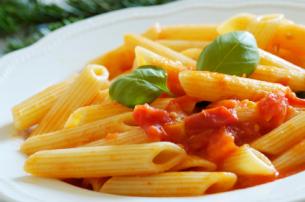Tip #1: Start with high-quality dried pasta. Barilla is always a good bet, but there are other inexpensive imported pastas that are as good or better. Dried pasta keeps for a long time, so stock up when your favorite pasta is on sale! If using fresh pasta, you should check it earlier. It will not take but two to three minutes for your fresh pasta to cook through.
Tip #2: Be sure to use a pot that holds a large amount of water. Pasta will cook evenly and won’t stick together if it is able to move around freely.
Tip #3: Salt! The secret ingredient to a flavorful pasta dish is flavorful pasta. The secret to flavorful pasta is salt in the cooking water. Fill the cooking pot with water, salt it liberally, and then put it on the heat. Once the water is warm (but not hot) and the salt has dissolved, taste it. If it’s not pleasantly salty (like a nice broth), add more salt. You’ll need at least a good handful of kosher salt for a five-quart pot of water, if not more. (Be careful: granulated salt is much more potent than kosher—it’s easy to over- or under-salt recipes if you switch back and forth between the two.)
Tip #4: Cook the pasta at a high enough temperature, and leave the pot uncovered. The other secret to pasta that doesn’t stick together is cooking it at a high simmer or low boil. If the water is in motion, the pasta will be, too, and it will not be able to stick to the bottom of the pot or to itself. If using small delicate pastas, such as tortellini or ravioli, lower the flame to a rolling boil so that your pasta will not break. Be sure to leave the lid off because if you cover your pasta it will come to a rapid boil, which we don’t want and it will also boil over. Never place your pasta in the pot before the water boils! The outcome will be overcooked and gooey noodles!
Tip #5: Always use one type of pasta per pot. Never cook more than one type of pasta in the same pot. Due to different sizes and shapes, pastas cook at different times.
Tip #6: Have your sauce ready before the pasta is done. Restaurants know the secret to making dishes come together perfectly. In the home kitchen it is a good idea to have your sauce warming on the stove before the pasta is cooked.
Tips #7: Do not rinse your pasta or toss with olive oil! If you plan on dishing out the pasta at the table or having it sit in a serving dish or platter for a while, you will need to do something to keep the pasta from fusing together before you serve it. Some people toss the pasta with olive oil. Although this gives your pasta a nice sheen, the best thing to do is to ladle a bit of sauce into the serving platter or dish and toss thoroughly. You can then place your sauce on top without having a sticky lumpy mass of pasta.
Tip #8: The cooking time on the package can be deceiving. Pay attention when cooking pasta. It’s color will change and it will become more pliable. As soon as it starts acting and looking more like cooked pasta than uncooked (approximately two to three minutes before the shorter cooking time on the box) scoop some out with a fork or a slotted spoon, let it a cool a second and taste it. Continue tasting it every minute until it’s ready to drain.
Tip #9: Drain your pasta BEFORE it is al dente. I take my cookies out of the oven just before they are completely baked. Cookies continue to cook after they come out of the oven and pasta is no different. It continues to cook in the colander or your serving dish, so if you drain the pasta when it’s the perfect consistency it will be overcooked by the time you serve it. When you taste your cooking pasta, you are looking for a consistency that is *almost* right, but is still slightly too firm. It shouldn’t be crunchy, but it should be more than al dente. If you are making a dish that will continue to cook further like lasagna, you should take it out two minutes early, when it’s even a little undercooked.
What is al dente pasta anyway? Perfectly cooked Italian pasta is firm and has a consistent, even texture. It is not crunchy or hard even at the center, but it is also not at all mushy or soft. When you take a bite from a dish of al dente pasta, each strand or piece of pasta will be distinct and will hold up in your mouth as you chew it instead of immediately mushing together.
Did you know?
I bet you thought that Italians gave birth to pasta. The Chinese actually invented the noodle over 4,000 years ago. The Romans got hold of this wonderful creation and added their own spin to it by substituting semolina flour over rice flour. Pasta making has changed very little since the early days, except for some automation that was brought about by pasta machines. Barilla is my personal favorite brand and we always use their whole grain pastas in our house!


 Hello, I’m Elise Johnson and I’m so glad you found your way here! From my own experience, cooking and eating together as a family nurtures and strengthens family relationships quicker and stronger than any other way. Join me as I continue my grandmother’s legacy of
inter-generational cooking by inspiring families and friends to make memories in the kitchen.
Hello, I’m Elise Johnson and I’m so glad you found your way here! From my own experience, cooking and eating together as a family nurtures and strengthens family relationships quicker and stronger than any other way. Join me as I continue my grandmother’s legacy of
inter-generational cooking by inspiring families and friends to make memories in the kitchen. 
Very good information. Wish I could get more info like this from other people! Thank you!
Can I just say what a relief to find someone who actually knows what theyre talking about on the internet. You definitely know how to bring an issue to light and make it important. More people need to read this and understand this side of the story. I cant believe youre not more popular because you definitely have the gift.
I truly loved this brilliant article. Please continue this awesome work. Regards, Duyq.
looks great!
Aw, this was a really quality post. In theory I’d like to write like this too – taking time and real effort to make a good article… but what can I say… I procrastinate alot and never seem to get something done.
This is such a great resource that you are providing and you give it away for free. I love seeing web sites that understand the value of providing a quality resource for free of charge. It?s the old what goes close to arrives around routine. Did you acquired lots of links and I see plenty of trackbacks?
I can see that you are an expert at your field! I am launching a website soon, and your information will be very useful for me.. Thanks for all your help and wishing you all the success.
Usually I do not post on blogs, but I would like to say that this article really forced me to do so! Thanks, really nice article.
Pretty good post. I just stumbled upon your blog and wanted to say that I have really enjoyed reading your blog posts. Any way I’ll be subscribing to your feed and I hope you post again soon.
Hey admin, very informative blog post! Pleasee continue this awesome work..
I observed your webpage on google and study a few of your other posts. I just added you to my Google News Reader. Keep up the amazing perform Look forward to reading a whole lot more from you inside the future.
Medical marijuana is actually quite a effective treatment for a great deal of folks, it does not matter what folks say. I know friends & family who’ve been helped with medical cannabis.
I truly loved this brilliant article. Please continue this awesome work. Regards, Duyq.
Good weblog, just looking around some blogs, appears a pretty nice platform you are using. I’m presently using WordPress for a few of my websites but looking to change one of them over to a platform comparable to yours like a trial run. Anything in particular you would recommend about it?
Hey, lovely website. I like your design. Mind if I link to you from my site at Chilli Plants?
I have got to hand it to you, you did a good job. The info is very appreciated.
Ahoi there, I just wanted to express how great this blog is!